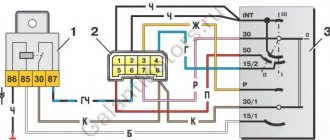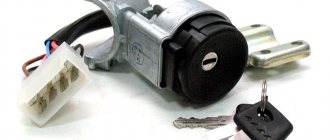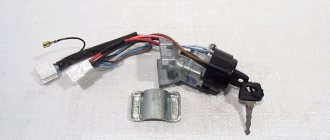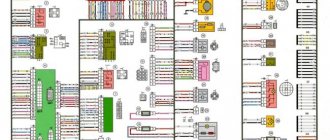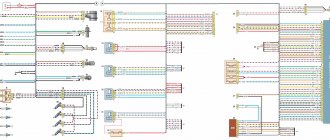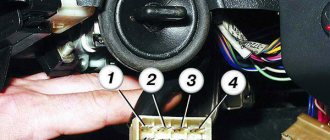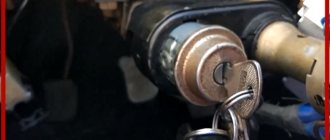Voltage is supplied to the electrical power circuits of consumers of electrical equipment of VAZ 2108, 21081, 21083, 2109, 21091, 21093, 21099 vehicles through the ignition switch (lock). For current unloading of the ignition switch contacts, an ignition relay 113.4737-10 is included in its circuit, which is mounted next to it under the instrument panel.
Ignition switch wires for VAZ 2108, 21081, 21083, 2109, 21091, 21093, 21099 cars, connection order, pinout
Ignition key position: “O” (off)
The lock contacts “30” (pink wire – “plus” from the generator) and “30/1” (brown wire – “plus” from the generator) are energized. No electric current flows into the system.
Key position: “I” (ignition)
Contacts “30” (pink wire) and INT (black wire) are closed. Voltage is supplied through one black wire to the exterior lighting switch, instrument lighting switch, through the other to the steering column switch for briefly turning on the high beam headlights.
Contacts “30/1” (brown “positive” wire) and 15/2 (blue wire) are closed. Voltage is supplied to the generator excitation winding, the ignition system, to the windshield wiper, carburetor solenoid valve control unit, turn indicators, reversing lamps, and control devices.
Contacts “30” (pink “positive” wire) and “15/2” (blue wire) are closed. The low and high beam headlights, fog lights, headlight cleaners, rear window cleaner, heated rear window, washer, heater fan, and engine cooling fan on the radiator are turned on.
Key position “II” (starter)
Contacts “30” (pink wire) and “50” (red wire to the starter) are closed.
In addition, “30” and “INT” remain closed, as well as 30/1 (brown wire) and “15/1” (white wire on the ignition relay).
Key position “III” (parking)
“30” and “INT”, “30/1” and “P” are closed (on VAZ 2108, 2109, 21099 cars this contact was used to turn on the parking light, the wire is yellow).
Notes and additions
— They are not powered through the ignition switch: emergency, sound, light alarms, interior lighting, dimensions, brake lights. security alarm. electric door locks (if equipped).
More articles on electrical equipment of VAZ 2108, 2109, 21099 cars
The electrical equipment system of VAZ 2108, 2109, 21099 vehicles is equipped with an ignition relay 113.4737-10.
Purpose of the ignition relay 113.4737-10 for VAZ 2108, 2109, 21099 cars
The ignition relay is designed to supply voltage from the ignition switch to consumers of the vehicle's electrical equipment system (for example, to the ignition system - to the ignition coil, switch), as well as for current unloading of the ignition switch contacts.
Where is the ignition relay for VAZ 2108, 2109, 21099 cars located?
The ignition relay on VAZ 2108, 2109, 21099 cars is installed next to the ignition switch. It has a bracket on its body that fits onto a pin under the instrument panel to the right of the driver.
Operating principle of the ignition relay 113.473710
After turning the key in the ignition switch, voltage from terminal 15/1 of the lock is supplied to the control contact of the ignition relay (85). The core inside the relay is drawn into the windings, closing contacts 30 and 87. In this case, the electric current from the generator arriving at pin 30 of the relay is supplied to pin 87 and then from it to the ignition system.
Ignition relay device
Notes and additions
— For the connection diagram of the ignition relay, the assignment of its contacts and wires, see the page: “Ignition switch wires for VAZ 2108, 2109, 21099 cars.”
More articles on electrics of VAZ 2108, 2109, 21099 cars
For the VAZ 2109, as well as for all other cars, the ignition switch is one of the most basic elements of electrical equipment. This element consists of a mechanical and electrical part. The mechanical part is responsible for locking the steering wheel when there is no key in the lock, and the electrical part is responsible for supplying voltage to the necessary electrical circuits depending on the selected position.
Name of modes, position of the lock and power circuit.
| Key position in the lock | Live pin numbers | Circuits that are included |
| 0 - disabled | 30 and 30/1 | The car is de-energized, power is provided only in circuits connected directly to the battery |
| "I" - ignition | 30 - INT | At the current position of the key, the external lighting, high and low beam headlights, instrument lighting and lighting in the car interior work. |
| 30/1 — 15/1 | All control devices, reversing light, windshield wiper, generator excitation winding, direction indicators, idle speed solenoid valve control unit must work. | |
| 30/1 — 15/2 | In this position, the low and high beam headlights, rear front fog lights, rear window cleaner and heating, washer, heater fan, engine cooling system fan, and headlight cleaners operate. | |
| "II" - starter | 30 - INT | The same circuits operate as in the ignition position. |
| 30/1 — 15/1 | The same circuits operate as in the ignition position. | |
| 30 — 50 | The starter turns on | |
| "III" - parking | 30 - INT | The same circuits operate as in the ignition position. |
| 30/1 - R | Parking lighting |
Typical faults
VAZ 2109 ignition switch
The lock belongs to the car's ignition system. Let us note right away that if problems are observed, you can fix them yourself, because, as a rule, the “nine” is equipped with an outdated ignition system that does not require diagnostics and repair at a service station.
How to make sure there is a problem
Below is a tip on how to make sure that the ignition switch is really not working:
- We insert the ignition key and turn it to a certain position. A short circuit in the circuit must necessarily occur. We look at the diagram: if the key is in position “1”, is the external lighting or control devices working;
- It is recommended to check at all positions of the lock. If deviations from the norm are observed, there is a problem with the lock;
- You can also check the functionality of the ignition switch in the following way: turn the steering wheel, which should not be blocked. The lock on a working steering wheel should only work when the key is turned a second time from position “1” to position “2”;
VAZ 2109 ignition switch malfunction
- You can reliably check whether the lock works like this: take an ordinary portable lamp and connect one end to ground, the other to the lock. We turn on the ignition - if the light is on normally, then the lock is in order. If the light glows dimly or does not light at all, the lock is faulty.
Malfunctions of the ignition switch in a VAZ 2109
Common faults
Among them, the following are in first place:
- The lock is jammed. This is even observed in the “nines” when a new lock is installed. The reason is a manufacturing defect or what is given below.
Note. The lock may also jam due to problems interacting with the starter. In this case, you need to inject a little silicone grease inside the lock and do this every time the lock jams.
- The lock may wear out over time and this will cause it to perform poorly;
- The ignition switch easily becomes unusable in the event of an unsuccessful attempt to steal a car, as well as any careless handling.
How to check the serviceability/failure of the ignition switch of the “nine”?
The ignition switch, like any other element of the car, can fail. In such a situation, it is necessary to either repair the ignition switch or, in case of a serious malfunction, simply replace this element with a new one. However, in the latter case, before carrying out this very replacement, you should make sure that the ignition switch is actually faulty. How to do it?
The ignition key must be inserted into the ignition switch and this key must be installed in a certain position. During such actions, the circuit must be closed, which is used to judge the functionality of the lock. For example, when the ignition key is turned to the third position, the security system should begin to operate, and when the key is turned to the zero position, this system should turn off. Any deviations here will indicate actual problems with the ignition.
Another way to check the lock's functionality is to turn the steering wheel. It shouldn't be blocked. The lock should only operate when the ignition key is turned a second time from the first position to the second. And the key, as you know, can only be turned to the second position from the zero position.
Correct operation and repair of the ignition switch
The operation of the ignition switch has several subtleties that especially need to be taken into account in older cars.
It is important to remember the following:
- The key must be turned smoothly and without jerking, and the key must not jam or slip (if this happens, the lock must be checked and repaired);
- Do not turn the key to the “Stater” position when the engine is running, as this may lead to damage to the starter. Many modern locks have a function to block the key from turning when the engine is running;
- Do not leave the ignition key in the “ON” position when the engine is stopped, as this will discharge the battery;
- To lock the steering wheel, you must first remove the key and then turn the steering wheel in one direction or another until it stops.
Some cars have other features of the ignition switch; they must be indicated in the operating instructions.
The ignition switch is one of the most reliable parts of a car, but over time it can also fail. The most common problems encountered are jamming of the cylinder, wear of the cylinder, wear and corrosion of contacts, or mechanical damage to the contact unit. If the cylinder fails, the lock is replaced completely; if the contact unit breaks, only it can be replaced without touching the cylinder. However, today, in case of any malfunction, the lock is most often replaced completely, since this is easier and cheaper than disassembling and repairing the old lock.
It should be noted that some problems can be solved without replacing the lock. For example, if the lock jams, especially on domestic cars, you can try treating the cylinder with graphite lubricant. And damage to contacts or conductors in a contact assembly can be repaired by soldering or replacing these parts.
In general, the ignition switch usually does not cause problems for the car owner; in good condition, it provides easy operation and protection against theft, and lasts for many years.
The most common ignition switch problems.
Many owners of "nines" note one unpleasant feature of their iron "horses" - that over time, the ignition switch in them simply begins to jam. Even if it was installed quite recently. Most likely, this defect is a manufacturing defect and you need to contact the store where you purchased the new ignition switch (for this purpose, it is better to save receipts for such purchases) to make a return. However, if this option is not available to you, do not despair!
The fact is that when the ignition switch jams when starting the engine, voltage is supplied to the starter, which can lead to failure of this part. But this does not mean at all that you need to run to the auto store for a new part. In this situation, you can simply buy silicone grease and apply it inside the lock every time the lock jams.
Ignition switch consumers.
This article will be useful to those who want to upgrade the ignition switch (for example, start the engine with a button) or are experiencing problems with the lock. Only the electrical part of the lock is described. We will consider the ignition switch in the VAZ-2114 version. It, unlike the VAZ-2108 lock, works in conjunction with the ignition relay.
The lock has 4 positions, of which only 3 are actually used:
0 - all consumers are turned off (used extremely rarely) 1 - ignition is on 2 - starter is on 3 - parking (the key is removed from the lock) Voltage from the battery is always supplied to contacts 7 (pink) and 8 (brown) of the lock. These wires are connected in parallel and connected in the mounting block. The division into two wires was apparently done for reliability, or it may have developed historically - these wires can be replaced with one wire. The brown wire connects the ignition system (carburetor version), instrument panel and some other consumers. Pink is responsible for the rest of the load.
How to determine that there is no spark on a VAZ 2109 (carburetor)
If an attempt to start the engine fails, you may suspect an ignition problem. not try to start the engine more than 3 times , as the battery will be discharged and the malfunction will not go away on its own . We need to start looking for the reason for this state of affairs. The search for a possible malfunction is done with an assistant who could turn on the ignition switch at the right time. A simple household multimeter will be useful for this work.
The first step is to check the performance of the coil, since it produces a high-voltage discharge. The simplest test is this:
- remove the high-voltage wire from the distributor cover;
- wearing gloves (to prevent electric shock) or taking the wire with pliers with insulated handles, bring its contact to the ground at a distance of about 1 cm;
- the assistant turns on the ignition (starter);
- A large blue spark should appear.
If there is an electrical discharge, the search for the cause is directed towards the distributor and spark plugs; if not, the coil, switch, Hall sensor, and ignition switch are checked. Let's consider how to independently check the serviceability of the listed devices.
Coil
Before checking the coil, it is worth checking the integrity of the central high-voltage wire, since its malfunction may also be the cause of the lack of a spark. To do this, the tester switch is set to the 20 kOhm position, and its probes are connected to the opposite contacts of the armor wire. If the multimeter shows values between 3.5 and 9 kOhm, the high voltage wire is OK. For other values, the wire is replaced with a serviceable one.
The ignition coil is the most capricious circuit element for diagnostics.
If the armored wire is working properly, the coil is tested. We check the integrity of the primary winding. The multimeter probes are connected to the “B” and “K” terminals of the coil. The switch is in the 20 Ohm position. Normal resistance for a device installed on the “nine” will be in the range of 0.4–0.5 Ohms.
To check the resistance of the secondary winding, connect the probes to terminal “B” and the high-voltage output. Tester switch in position 20 kOhm. The normal resistance value is within 4–5 kOhm. If the resistance readings are very different from normal, the coil is replaced with a new (good) one.
Switch
If the coil showed normal resistance figures, it is not the reason for the disappearance of the spark. Next along the chain is a switch. The tester will not be able to “ring” it. The functionality of an electronic device is checked by replacing it with a known good one. If the “live” switch has not changed the situation, you need to move further along the chain.
Hall Sensor
This device is treated in the same way as a switch (replaced with a functional one). The difference is that the Hall sensor is more difficult to reach. To do this, you need to disassemble the distributor.
Egnition lock
If the coil, commutator and Hall sensor are working properly (do not forget to check the integrity of the contacts between these devices), but the spark does not appear, the reason may lie in the ignition switch. When the lock is turned on, power is supplied to the coil. It is checked like this:
- the tester switches to 20 volts;
- one multimeter probe to terminal “B”, the other to ground;
- When the battery is charged, the device will show 12 V.
Wiring diagram for the ignition switch on the VAZ-2108, 2109 and 21099
Wiring diagram for the ignition switch on the old-style VAZ-2108, 2109 and 21099 with an unloading relay.
Pinout of the VAZ-2109 ignition switch with unloading relay:
- comes +12V in position I, II, III (parking)
- comes +12V in position I, II, III (parking)
- comes +12V in position III (parking)
- position I, +12V goes out after turning on the ignition (contact 15/2), disappears at start (II);
- position I, +12V goes to the starter (pin 50);
- position I, +12V goes away after turning on the ignition (pin 15), does not disappear when starting II;
- +12V comes from the battery (pin 30);
- comes +12V constantly.
Wiring diagram for the ignition switch on the VAZ-2108, 2109 and 21099 of the new model, without a relay.
Pinout of the new VAZ-2109 ignition switch:
- comes +12V constantly
- comes +12V constantly
- +12V arrives after turning on the ignition (pin 15), does not disappear when starting II;
- +12V arrives after turning on the ignition (contact 15/2), disappears at start (II);
- position I, +12V goes to the starter (pin 50);
- +12V arrives after turning on the ignition (pin 15), does not disappear when starting II;
- +12V comes from the battery (pin 30);
- comes +12V constantly.
Photo 1, pinout of the new VAZ 2109 ignition switch
Photo 2, pinout of the new VAZ 2109 ignition switch
Troubleshooting Methods
There are two methods for detecting faults:
Ignition switch circuit
We suggest studying a visual method for determining a malfunction or breakdown of the contact elements of the ignition switch using the table.
To work, you will need a mini-tester and a multimeter in ohmmeter mode:
- Disconnect the power supply from the ignition switch. To do this, you need to remove the skin from the steering column;
- Switch your multimeter to an ohmmeter;
- On the block coming from the lock you need to find pins 7 and 4, which correspond to pins 15 and 30;
- Connect the multimeter probes to them;
- Turn the key to the “Ignition” position;
- On the block, find pins 7 and 3, corresponding to 50 and 30. Also connect a multimeter to them;
- Turn the key to the second position - Start the engine;
- If serviceability is present, the device will show zero resistance in both test cases.
Ignition switch VAZ 2109 faults
The ignition switch of the VAZ 2109 is a very important and at the same time very capricious mechanism of the car. And in today’s article we will try to analyze its importance and capriciousness, i.e. its malfunctions. The ignition switch serves to supply voltage to electrical circuits depending on the location of the key. The castle consists of 2 parts. These are the mechanical and electrical parts.
As has already been written, in our nine the ignition switch is a very important mechanism. Almost all of the car's electrics pass through it. Without an ignition switch, only a few devices can operate and these are:
1. Side lights.
2. Emergency alarm.
3. Interior lighting.
5. Rear number plate illumination.
This is necessary so that when stopping on the highway or in the city in an unlit place, we do not need to turn on the ignition in order to be noticed.
Operation of the ignition switch
In general, the operation of the ignition switch is extremely simple: when you turn the key, the contact disk rotates and certain electrical circuits of the car are closed. Moreover, turning the lock is possible only when using an individual key; it is impossible to start the car with another key.
Ignition switches can have three, four or five positions:
- “Off” - in domestic ignition switches it is designated as “0”, although in some older cars this lock position was designated “I”. In modern foreign-made cars, this position is not fixed or indicated on the lock;
- “On” or “Ignition” - in domestic locks it is designated as “I”, although sometimes “II” is also found (in Moskvich cars), in modern cars this position is designated “ON” or “3”;
- “Starter” - in domestic cars it is designated as “II”, on some models you can find the designation “III” (in Moskvich cars), in modern cars it is designated “START” or “4”;
- “Locking” or “Parking” - in domestic cars it is designated as “III”, sometimes as “IV” (in Moskvich cars), in foreign cars it is designated “LOCK” or “0”;
- “Additional equipment” - in domestic ignition switches there is no such position; in foreign cars it is designated as “Acc” or “2”.
VAZ 2109 ignition switch diagram.
The ignition locks for the VAZ 2109 can be of different designs. There are 2 samples, this. new and old. The new one differs from the old one only in the absence of a relay, a shortened key and three key positions instead of four.
1. Ignition relay
2. Ignition switch connector
3. Ignition switch.
Ignition replacement and check
To replace the ignition switch, you need to perform all the steps in a certain sequence:
- Before replacing, you must remove the negative terminal from the battery.
- Remove the steering column cover and the two switches located under the steering wheel.
- After this, you need to insert the key into the ignition switch and set it to the zero position. This is necessary for the anti-theft device to be disabled.
- Next, unscrew the 4 bolts that hold the ignition switch. If bolts with sheared heads are installed, knock them down using a hammer and chisel.
- After unscrewing (knocking down) the bolts, remove them from the holes using pliers.
- On the left side, remove the bracket, and then on the right side, remove the ignition switch.
- Then disconnect the wire block from the electrical connector.
- Get under the dashboard and disconnect the ignition switch connectors from the relay.
Installing a new lock must be done step by step in reverse order.
To check the contacts on the wire block, use an ohmmeter. The device must display zero. If his readings are different, change the contact group.
To change a contact group, you need to do the following:
- Using a screwdriver, unscrew the screw that secures the cover.
- Bend back the plastic latches that hold the cover in place, then remove it.
- Remove the contact group.
The contact group is also installed in the reverse order.
Not in all cases it will be possible to find four bolts on the steering column on a VAZ-2109. On some models it can be secured with two bolts and a hook.
The ignition switch of the VAZ 2109 is faulty.
The most common problem with the ignition lock is its working out and jamming. If these symptoms occur, you should immediately replace the entire ignition switch, because in case of jamming, you can simply burn the starter and then the repair will cost you the cost of the starter. Another common problem is the failure of the contact group. In this case, several devices fail at once. For example, my low beam headlights, heater, cigarette lighter, and rear window heater immediately stopped working. Replacing the contact group with a new one, everything worked immediately.
© 2022 Repair and tuning of domestic cars Joomla! is Free Software released under the GNU General Public License.
Removing a faulty lock
Unscrewing the ignition switch bolts with a chisel
In practice, replacing the ignition switch on a VAZ 2114 will be impossible until you get rid of the old one. This is not difficult to do, but you will have to spend some time on your car.
- Once you have gained access to the ignition switch, or rather its housing, you will notice that the lock is attached to the steering column with four bolts. The problem is that they don't have heads.
- This phenomenon is part of the “unique” factory anti-theft system manufactured by AvtoVAZ. In fact, such a system makes it somewhat more difficult for criminals who do not have a key to start the engine. So don't scold them too much.
- These bolts are loosened with a chisel and hammer, and their removal is done using pliers.
- Next, remove the bracket from the column;
- Be sure to unplug the power supply. In general, the wiring diagram for the VAZ 2114 ignition switch is simple if you buy the lock assembled. You don't have to solder anything or figure out which wire goes where. Everything is assembled into a block, so all that remains is to insert it into the appropriate connector. That's all.
- By disconnecting the power supply, you can now finally get rid of the failed ignition switch.
Design and troubleshooting of the ignition switch of the VAZ 2109
One of the key components on a VAZ 2109 vehicle is the ignition switch. The electrical circuit of the machine uses it as a switching unit, providing voltage to the necessary power circuits. If this does not happen due to a malfunction of the switch, then it is possible to turn off individual groups of consumers or the car as a whole - it simply will not start.
Purpose and device
The main purpose of the lock was initially to protect the car from theft, however:
- Today, as can be seen from practice, in order to start and steal a car, car thieves do not necessarily need to have a key or a duplicate of it
- To put it more clearly, the protection from the castle used to justify itself, but today it is “so-so”
- Advanced car thieves, equipped with modern technologies and devices, are able to hack the electronic protection of the most modern anti-theft systems in just a few seconds.
- And on the VAZ 2109, the lock cylinder or the VAZ 2109 lock itself, or its domestic analogue can generally be called entertainment for beginners
- In fact, the ignition switch is an ordinary switch that, when you turn the key, opens or closes a certain group of contacts
- The appearance of a malfunction in the ignition switch increases the likelihood of vehicle theft several times, in addition, it creates great trouble for you and, according to the law of meanness, at a completely inappropriate moment for this
- The design of any ignition switch is similar; it consists of a lock and its contact group
- And the contact group consists of two separate plates, fixed and movable
- The movable plate moves when the key is turned in the lock and the contacts are closed in the required sequence
- Already now, switches that have the same design and order of contact closure are successfully used on all domestic cars
Reasons for replacement
As a rule, replacement of VAZ 2109 lock cylinders is carried out in the following cases:
- When they tried to steal a car and the lock cylinder was damaged in the process
- If the owner of the car has lost his keys
- Breakage of the larva during operation
The car engine may not start due to poor contact. It’s not at all difficult to check this; to do this, it’s enough to have an ohmmeter on hand, or a multitester with an ohmmeter function and five minutes of time:
- Disconnect the “-” terminal from the battery
- Remove the lower casing from the steering column
Removed the casing and opened the contacts
- Disconnect the contacts and check the resistance with an ohmmeter
- Serviceable contacts should have minimal (zero) resistance
- Otherwise, you need to replace either the contact group or the entire lock
We measure the contact resistance using an ohmmeter
Design and principle of operation of the lock assembly
On a VAZ 2109 car, 2 standard modifications of the lock can be installed. The old one has catalog number 21080-3704005-60. It features four key positions (long), and also contains an ignition relay. The new unit with catalog number 21080-3704005-30 has only three key positions and does not have a relay.
To connect all the wires to the VAZ 2109 car lock, a contact group is used. Each of the key positions has its own blocking, and therefore consumer groups.
Contacts “30” and “30/1” are closed. All dependent power circuits are disabled.
In this position, voltage is supplied to the elements of the ignition control system. To do this, the white and brown wires are connected, and the pink wire is connected to black and blue. In this case, several groups of contacts are formed. For example, “30 INT” turns on the power supply circuit for external lighting, including high beam lighting, and the dashboard lighting. Contacts “30/1” and “15/1” provide voltage to the direction indicator lamps, reverse lights, elements of the ignition system, etc. The pair “30/1”, “15/2” powers the low/high beam headlights, fog lights , washer, fans.
The ignition relay, which was switched on in the previous step, continues to operate. The main one is a pair of contacts “30”, “50”, which provides voltage for the starter to operate. In parallel to it, circuits should be formed from contact connections “30/1”, “15/1”, as well as “30/1”, “15/2”. The consumers that are connected in this case are similar to those described for position “I”. The pink wire in the contact pair, together with the black one, is shorted to red (instead of blue).
Used to supply voltage to the components of the parking (“30/1 P”) and side lighting/dashboard lighting (“30 INT”) components. The black wire forms a closed circuit with the brown and pink wires.
The lock and its circuit perform two functions: electrical and mechanical. The essence of the first is to close certain groups of contacts based on the position of the key. From a mechanical point of view, when the ignition is turned off, the steering wheel is blocked, making it impossible to rotate. That is, the second function is protective.
What is
First, let's look at the structure of the castle. Let's find out what it looks like, what it consists of, what its operating principle is, and so on:
- As mentioned, the ignition switch is a very important element of the VAZ 2109 car, because almost all available equipment is connected to it.
Note. Although there are components that do not depend on the lock in any way. Here they are: license plate lights, brake lights, parking lights, hazard lights, interior lights and lights on the dashboard.
- There are different types of ignition switches: new or old type. The first version without a relay has three positions and a short key, the second with a relay has four positions and a long key.
VAZ 2109 ignition switch malfunction
Scheme
Detailed diagram
Below is a typical diagram of the ignition switch on the “nine”.
| In key position “0” | The VAZ 2109 is de-energized, and there is power only in the wires that go directly to the battery |
| In key position “1” | The following car components are working: external lighting, headlights, instrument lighting, interior light, all control devices, wipers, heated windows, etc. |
| In position “2” | The starter turns on and all position “1” circuits work |
| In position “3” | All circuits including brake light |
Possible malfunctions and ways to eliminate them
The nature of the lock assembly malfunctions on a VAZ 2109 car can also be electrical or mechanical.
The first group includes violations of the integrity of electrical circuits in the switch at a certain position of the key. If there is no contact, then the connected consumers may not work, or the car will not start at all. If there is contact, but the wrong parts of the circuit are closed, this is fraught with a short circuit and thermal damage to the lock. It will begin to melt and a characteristic smell will appear. Depending on the scale of the disaster, the contact group will most likely need to be replaced.
From a mechanical point of view, the core/larva may become stuck in some position. In this case, it will be physically impossible to turn the key in the lock. The only correct repair option is to replace the entire assembly.
To diagnose faults in electrical circuits, you need to stock up on the following tools.
- Multimeter or tester. If it is not available, as an option, you can use a control light operating at 12V voltage.
- A set of screwdrivers and keys for dismantling the lock. Since the only option for repairing mechanical faults is to replace parts that have failed, they will come in handy in this case as well.
Before starting diagnostics, you will have to disconnect the terminal block and ring all contacts in the sequence that corresponds to each of the key positions. For clarity, you should have an electrical diagram of the unit at hand. If the circuit is closed, there will be a resistance indication on the device.
Replacing the lock should begin with de-energizing it. To do this, you will have to loosen the fastening nut and remove the negative terminal of the battery. After this, the protective and decorative casing and the turn/window washer switches are removed. The lock is attached to the steering column using four screws or two screws and a hook latch. It may be difficult to remove due to the screws. In this case, they will have to be cut or drilled, doing everything extremely carefully. The terminal block is disconnected, and the dismantling process can be considered complete.
Assembling a new lock assembly occurs similarly, but in reverse order.
Repair and replacement
Typically, the lock can be repaired. If this fails, you will have to completely replace it (see Replacing the VAZ ignition switch on your own). Repairing a lock in most cases comes down to replacing the cylinder or contact group. If after this the problem has not been resolved or it is possible to change the entire lock, then it is better to do the latter.
VAZ 21093 ignition switch
Larva and its replacement
Larva
So, we do the following:
- Remove the steering column cover and unscrew the fastening bolts that tighten the ignition switch clamp.
Note. The bolts have sheared heads and then you will have to use a hammer and chisel. The bolts are first loosened by blows with a chisel, and then unscrewed with pliers.
- We separate the two parts of the clamp so that they disengage;
- The larva can be changed already at this stage of the operation;
- We take out the side pin that holds the cylinder in the lock.
Advice. The cylinder can be easily removed with a thin screwdriver, for example, from a watch. At the same time, you need to tap the lock with a hammer.
- If you cannot pull out the cylinder after the side pin has been removed, you can try to drill out the cylinder using a thin drill;
- If again it was not possible to remove the cylinder, then it is recommended to finally remove the lock;
- Remove the wire plugs.
Note. One of the plugs (the one with the larger connector) is located under the dashboard. To remove it, you need to put your hand under the panel.
- If the ignition switch has a relay, then take it out from under the panel;
- Disconnect the connector;
- We also remove the ground wire;
- Remove the cover by pressing the latch, and then the contact group;
- Now it will be much easier to remove the larva;
- We replace it with a new one;
- We check the work on site before putting everything back into place. We turn the key inside the lock - all the processes described above should work.
Note. Don't forget to also check that the steering wheel lock works. If the steering shaft does not lock when the steering wheel is turned completely, we adjust the correct location of the lock on the column.
- After a thorough check, making sure that everything works correctly, tighten the bolts until the heads come off. It is advisable to use the key at “10”.
contact Group
Lock contact group
Replacing the contact group of the lock, if this is the fault of the lock, is the most profitable from the point of view of monetary costs. The actions boil down to removing the lock (how to do this is written above). Here are some guidelines to follow:
- Before disconnecting contacts, you need to number them to avoid confusion;
- Some models of locks in the contact group design have a retaining ring, which must first be removed. This is most easily done using an awl.
In this way, malfunctions of the ignition switch on the VAZ 2109 can be eliminated with your own hands. During the work process, it will be very useful to study various photos, materials and diagrams, and watch a thematic video review. The cost of repairing or replacing the lock will be minimal, since all the work presented in our instructions is carried out independently.
